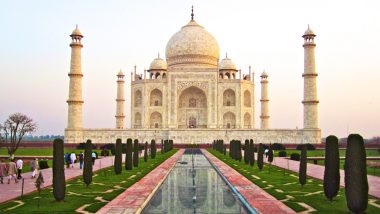India's iconic monument Taj Mahal is braving pollution from the last few years and the problem is only worsening, affecting the marble structure. Earlier in February, there were reports of the monument turning yellow, discolouring the marble which makes this structure. But now the case has only worsened as the colour changes to brownish and green tinge. The Supreme Court has expressed concern over this change and asked the UP government to rope in international experts to protect the monument. "We don't know whether you have or perhaps don't have the expertise. Even if you have the expertise, you are not utilising it. Or perhaps you don't care," a bench comprising Justices M B Lokur and Deepak Gupta said.
The SC demanded more serious action and willingness in protecting the monument. Additional Solicitor General (ASG) ANS Nadkarni, appearing for the Centre, told the bench that it was the duty of Archaeology Survey of India (ASI) to preserve and protect the monument. The ASI reacting to the apex court's concern said that their efforts will be in vain under the pollution is controlled. Advocate MC Mehta who has been fighting a legal battle in the protection of the monument pointed out that the Centre and State government both did not pay heed to the SC's initial orders, which has only resulted in more damage. Taj Mahal Tragedy: A 12-Feet Pillar Inside The Historical Monument Collapses Due to Heavy Rains in Agra
The bench was very sarcastic in their comment. It said, "Perhaps we need some expert organisation from outside India unless there is a decision that the Taj has to go." They constantly mentioned about getting in experts from abroad if need be. The ASI had conducted a preliminary study on the suspended particulate matter (SPM) around the mausoleum which indicated 'high.' Experts said that the dust and fumes have caused the damage to surface and fabric of the construction. This SPM recorded in Agra is almost three times more than what it should be in the residential areas.
When ASI officials had observed some insect patches on the mausoleum earlier, they had begun the mud-pack treatment. The ASI has had to do this treatment more than once. Insects breeding in the Yamuna river that flows behind the Taj is responsible for these growths on the white marble surface. The court has been looking into the conservation of this iconic monument in the country since quite a few years and had given restraining orders to control the rising pollution. Now once again, the SC has ordered a more serious action and help from the international experts if need be to protect this historic symbol of love. Taj Mahal was built by Emperor Shah Jahan for his wife Mumtaz Mahal between the years 1631 and 1648. It a UNESCO World Heritage Site and a major tourist spot in the country.
(The above story first appeared on LatestLY on May 02, 2018 04:20 PM IST. For more news and updates on politics, world, sports, entertainment and lifestyle, log on to our website latestly.com).













 Quickly
Quickly














 RCB
RCB







